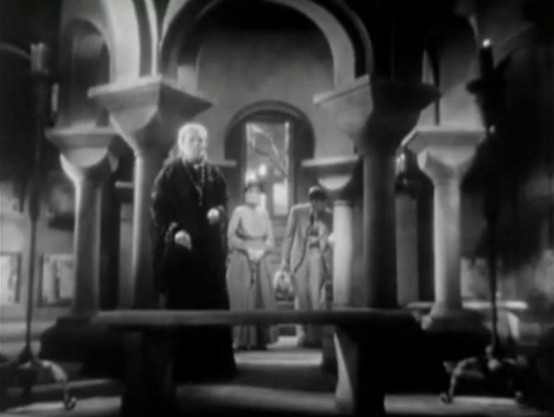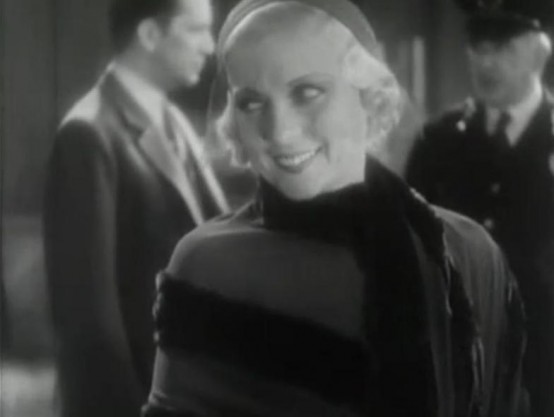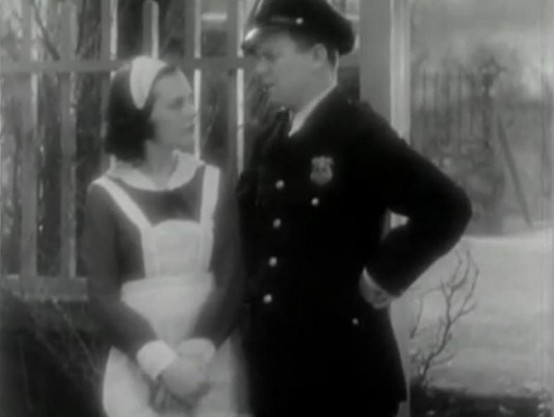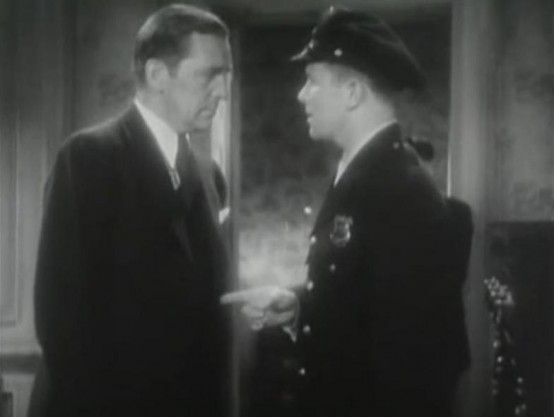Judging by the few comments and reviews I spotted online while researching Paramount’s Murder by the Clock, opinions as to its quality appear as divided today as they were in 1931 when the film was originally released.

Period ad for Murder by the Clock found in the Cumberland Evening Times of Maryland, September 17, 1931.
Pacing is the greatest modern criticism. It crawls, some say, though I wouldn’t be among them. Some of these early talkies take as much training to enjoy as a silent film does for someone who’s not used to them. I’m not suggesting that you work to enjoy the movie, just that deep immersion in the period helps you enjoy it more. During the pre-Code years overall film quality seemed to grow exponentially year to year, even month to month if you care to dig that far, and certainly studio to studio. Is Murder by the Clock slow? Perhaps, but I thought the pacing was a good year or two ahead of most of what I’ve seen from this time.
When it was originally released the horror elements were too much for some critics, who didn’t dismiss them as horrifying, but idiotic. Murder by the Clock was released in mid-1931, smack-dab between February’s Dracula and late November’s Frankenstein on the calendar. It was way too early for many higher-minded critics to appreciate the coming horror cycle as anything more than an overall cheapening of the movies.
Speaking as a newly minted Murder by the Clock fan, I’ll confess I mostly love the camp value of Lilyan Tashman’s twisted performance over all other aspects of the film. But beyond Tashman’s charms, spelled out in more detail below, I liked what many of the more favorable period critics liked, the thrills and shocks along the way, mostly unbelievable, but typically placed in all the right spots to make the movie’s 76 minutes breeze by for me.
Like most modern fans of the movie I have not read the 1928 Rufus King novel that the film was based upon. But I did read about it (links at bottom) and also read the excerpted first chapter from a period newspaper to get a feel for King’s style. The Valcour character, played by William “Stage” Boyd in our film, was making the first of eleven appearances in various novels by King published through 1939. That first novel, also titled Murder by the Clock, concentrates on the interaction between Valcour and Laura Endicott (Tashman in the film), but it appears as though most of the horror elements were added later, either by Charles Beahan, author of the unpublished and likely unperformed 1929 play, Dangerously Yours, or Henry Myers, who carved our movie out of King’s story and Beahan’s play. King’s own 1934 play, Invitation to a Murder, adapted to film as The Hidden Hand in 1942, features a trick burial gimmick reminiscent of what occurs in the movie version of Murder by the Clock, but absent from the original King story.
Where the burial bit originated, with King, Beahan or Myers, I’m not sure, but none of my supplemental research pointed to Murder by the Clock’s eerie burial alarm system appearing anywhere but in the Paramount film. And besides Tashman’s oozing wrath, it is the highlight of the movie.
Opening in a creepy graveyard–a set I’d be curious to happen upon in any other Paramount films of the period–elderly Julia Endicott (Blanche Friderici), clad in black and tapping her path with a cane, looks as though she’s leading the way to a black mass as she crosses the street from her old, dark house to the cemetery with her son, a very jumpy Irving Pichel as Philip, who follows behind clinging to his caretaker, Miss Roberts (Martha Mattox).
Mrs. Endicott leads this odd trio into the family tomb on the pretense of laying flowers at the grave of her long deceased husband, but Roberts knows the visit is for more selfish purposes. Mrs. Endicott defends herself, explaining, “I’m so afraid of being buried alive, without anyone knowing it.” She has reason. It happened to her Uncle Morton, who they found turned over inside his grave. Mrs. Endicott is visiting the family tomb to make sure her alarm works. She flips a switch and the loud signal sounds its repeated call, a foghorn like bellow in short bursts that on dry land sounds more like a series of thunderous moans from the beyond.
This alarm cries out punctuating two key scenes in Murder by the Clock before being heard once more during Clock’s climactic battle. It is not used as effectively in that final appearance as it had been earlier, but by this time we’ve become so attuned to the alarm that it’s like a favorite actor whose story wraps too soon, but we just need to see him–or in this case hear it–one more time before the end.
“I don’t want to see dead people,” Philip says while being forced to join his mother in the tomb. Irving Pichel looks like a giant Moe Howard with his bowl cut, but if he’s the most intimidating physical presence in Murder by the Clock then he’s also the least intimidating mental presence. “Nature treated you unkindly,” caretaker Roberts tells him, though we’re left unclear as to whether it was nature or nurture that molded dimwitted Philip into the psychopath Pichel plays in this movie. We’re left to assume Miss Roberts raised him from the cradle and is the only person in the world with any empathy for the highly disturbed heir to the Endicott fortune.
But Philip isn’t heir for long. After returning from the cemetery he manages to impress his depravity upon Mrs. Endicott just enough for her to disinherit him. She asks what he’d do with himself if she and Roberts were to disappear forever. His gleeful one-word response: “Kill!” Mrs. Endicott, hoping for the best, suggests, “You want to be a soldier?” But Philip says no, he doesn’t want to use guns to kill. Instead, he grips the knife by his dinner plate and declares, ”Knives!” He drops the knife to offer a more intimate alternative: “Or with my hands.”
Mrs. Endicott is disgusted. “And you’re to inherit the Endicott money and power,” she says. “What a thing to leave behind.”
That evening she puts in a call to her nephew, Herbert (Walter McGrail), and has her lawyer make over her will in his favor. “So my heir will be either a drunkard or a beast. A bitter choice. Everything considered, I choose the drunkard.” Everything is to go to Herbert except a trust fund for Philip and orders for Roberts to stay on at the house to take care of him. Herbert and his wife, Laura (Tashman), must live inside the Endicott mansion in order to inherit the Endicott money.
While Herbert is anointed as heir his wife doesn’t bother waiting around outside for him. Instead she visits Tom Hollander (Lester Vail), a sculptor who is desperate for her to leave Herbert and become his wife. While there she does her best to keep his hands off of her while managing to finagle money out of him simply by speaking out against the idea: “Tom, please don’t ask me to accept money from you again,” the lilt of Tashman’s husky voice cluing in everyone except Tom that money is exactly what she’s after.
Back home that night Laura remains unsatisfied with Herbert’s station despite his being made full heir to the Endicott fortune. He offers to borrow some money from Tom Hollander to get them by, but Laura won’t hear of such a dreadful idea. Especially since she’s already put the bite on Tom. Instead she suggests that Herbert would be heir if his aunt died tonight. “If she died tonight,” he repeats after her. Laura’s big eyes flash towards him and knowing perfectly well what he’s thinking of, she asks, “What are you thinking of?” He dismisses her. “Just thinking,” he says.My limited experiences with Lilyan Tashman lead me to believe that the actress went over-the-top with her part on purpose. Perhaps director Edward Sloman should have had her tone it down, yet Tashman’s extreme vamping survives as one of the greatest delights of Murder by the Clock. The sexy actress slinks through several different costumes, each more formfitting than the last, purring at all of the men in a rehearsed tone that bares her every thought to the viewer, but simply teases all of the fellows in the movie. She knows they all want her and arouses each of them into such a frenzied state of confusion that she can easily laugh in their faces and treat them all like children.
Tensed fingers soon extend from a looming shadow towards Mrs. Endicott’s throat and the rich old lady is strangled to death the same night she had adjusted her will. The police are certain that Philip did it and the strapping psycho does himself no favors when he happily proclaims that he spends his days thinking “about killing” and displays his strength to them by snapping an andiron in half by the fireplace. Given Herbert’s sweaty panic it’s rather shocking that the police are willing to overlook any possible involvement on his part, but they’ve got an easy mark in Philip. The chief calls it an open and shut case, pleasing Laura to no end, and all of the other parties on hand, including the medical examiner, are happy to accept Philip as the murderer.
Except William Boyd’s Valcour. He insists that given Philip’s strength Mrs. Endicott’s neck would be broken had he been the one to strangle her. “I’m not interested in jigsaw puzzles,” his boss says. “The case is closed.”
Valcour’s determination for justice allows him to see through the rest of the department’s willingness to overlook wealthy and well-behaved suspects in favor of the household madman and then later overcome all of the vamping and zero in on Laura as a person of interest. When the two tango outside of the police department, Laura’s sour word already having served to demote Valcour from Lieutenant to Sergeant, she compliments him as, “a very interesting woman.” He thinks the same of her adding that she has a look in her eyes that he finds characteristic of two types, “Inspired geniuses and killers.”
Valcour remains immune to the hypnotic effect Laura holds over all other men. After she inspires Philip’s escape from prison (“Wouldn’t you like to come real near me and hold me in your arms?”), Laura calls for police protection and Valcour gains entry back inside the Endicott mansion. He foils Laura’s constant come-ons by finally telling her, “I’m in love. With my job.”
As Murder by the Clock progresses Laura’s conniving causes two additional murders as well as creating the two additional murderers who commit them. Beyond those three kills by three different killers, one of those victims is bought back to life by a shot of adrenaline to the heart, allowing him to die all over again for a second time! Unfortunately he was resuscitated just in time for the shock of Mrs. Endicott’s alarm sounding from the graveyard across the street. With nearly all of the surviving parties gathered together in the same bedroom the familiar tapping of her cane proceeds their witnessing her crossing the balcony.
“It’s old Mrs. Endicott, she’s risen from her grave,” says Jane, the maid (Sally O’Neil).
Valcour asks if Mrs. Endicott had a bad heart, perhaps thinking that she too has been revived by adrenaline. “Yes sir,” the maid says. “Maybe she was buried alive, she was always afraid of that.”
“She is alive,” Valcour says, before paying a quick visit across the way to confirm that her tomb is indeed empty.
Murder by the Clock is populated by creepy characters and dark story elements and additionally dominated by Lilyan Tashman’s portrayal of a character often described as a modern Lady Macbeth. An unsigned New York Times review aptly describes the Laura character as, “a girl, on the vampire style, using the old connotation of the word and not the new,” placing Tashman in the style of Theda Bara rather than Bela Lugosi. But if Tashman’s vamping is fifteen years out of style she might be a good forty years ahead of the times in her blatant use of sex to get what she wants. The most interesting thing about Tashman’s Laura is that she neither actually kills nor seduces in Murder by the Clock, but instead seems to get off on the idea of calling out these animal instincts in others, simply because she can.
While this won’t work on Valcour she reduces the other men in her life to primal beings no better than the lecherous Philip, who is already expected to behave like a beast.
I was pleasantly surprised by William “Stage” Boyd’s performance as Valcour. He reminded me quite a bit of another period character actor I’ve seen a lot of lately, Thomas E. Jackson, though Jackson was always a supporting actor and never reached Boyd’s star status, brief though it was in movies. Boyd’s breezy delivery is especially enjoyable as he parries with Tashman. “It’s a poor murderer that has to be present when the crime is committed,” he tells her after a killing. He soon adds, “I’ve encountered a lot of alibis, but this is the first time I’ve ever been one.”
I haven’t mentioned Regis Toomey yet and that’s probably not fair because he and Sally O’Neil were both enjoyable as the courting Irish cop and Endicott maid, who flirt and banter in between the more serious scenes upstairs. As the body count rises both characters wind up interacting more with the other actors and Toomey’s Officer Cassidy eventually serves directly in aid to Boyd’s Valcour. It’s Toomey’s cop who actually coins the title of the movie after suggesting one of his several pulp-inspired murder theories to Valcour.
“This is no mystery case,” Valcour tells him. “We’re up against a murderer whose mind works like a clock.”
“Murder by the clock, what will they be doing next,” Cassidy replies.
Hard to find and never on video, for years horror fans were teased by William K. Everson’s inclusion of the title in his 1974 Classics of the Horror Film. Everson wrote, “Murder by the Clock created quite an impact on its original release,” adding, “Those who saw it then remember it fondly, and talk of it with an appreciative shudder.”
Everson refers to director Edward Sloman as “a good silent director,” though I haven’t seen any of Sloman’s other work. He’s obscure enough for Murder by the Clock to be his most voted upon title at the IMDb. Better remembered is cinematographer Karl Struss, who had already won a share of an Academy Award for Best Cinematography in 1929 for Sunrise: A Song of Two Humans (1927), and would receive the first of three additional nominations soon after for another classic, Dr. Jekyll and Mr. Hyde (1931). In Murder by the Clock, Struss captured some of the most chilling shots of the period around the graveyard and inside the Endicott family tomb.
While Murder by the Clock is not as slick or well-acted as other early Paramount horror films, such as Island of Lost Souls (1932) or Dr. Jekyll and Mr. Hyde, it’s a strong thriller with several twists. It should be enjoyed by anybody who likes the early Universal horror films, which it felt slightly more akin to than those titles from its own studio, Paramount. If the pacing of Dracula (1931) doesn’t bother you, then neither will this.
As I already mentioned, Murder by the Clock is not available on home video, but you can hunt it down through grey market suppliers or, as of this writing, head over to YouTube and view it for free.
Recommended Reading
- Pretty Sinister Books looks at Rufus King’s novel Murder by the Clock
- Scroll down this page at Mike Grost’s website for more about Rufus King and criticism of some of his work, including Murder by the Clock.
- Keep reading beyond this review of the film into the comments section where the reviewer converses with both Pretty Sinister Books and Mike Grost about the adaptation.
- If you’d like to read more about Lilyan Tashman my friend Karen at Shadows and Satin has written a lengthy post about the actress that’s both informative and thoughtful. Skip Wikipedia, this is the ultimate Lilyan Tashman biography.





















Another one that sounds right up my alley.
Oh yes, Will, it definitely is!
Loved your write-up, Cliff — although it’s not my favorite Tashman film, anything Lilyan does is just all right with me. And thank you so much for the lovely mention! It is most appreciated. 🙂
Thanks, Karen! The few others I’ve seen her in were supporting roles, so this has been my best exposure to Tashman. I think she’s genius here in a kitschy Myrna Loy Fu Manchu kind of way, though a tad more reserved than Myrna in a more important part. No problem for the link, your bio is my favorite post I’ve run across in awhile–I love it when the internet can beat the textbooks!
I just watched ‘Murder by the Clock’ a month ago, and the foghorn/crypt alarm sounded so much like a person’s voice to me. (Which actually made it creepier.) What do you think?